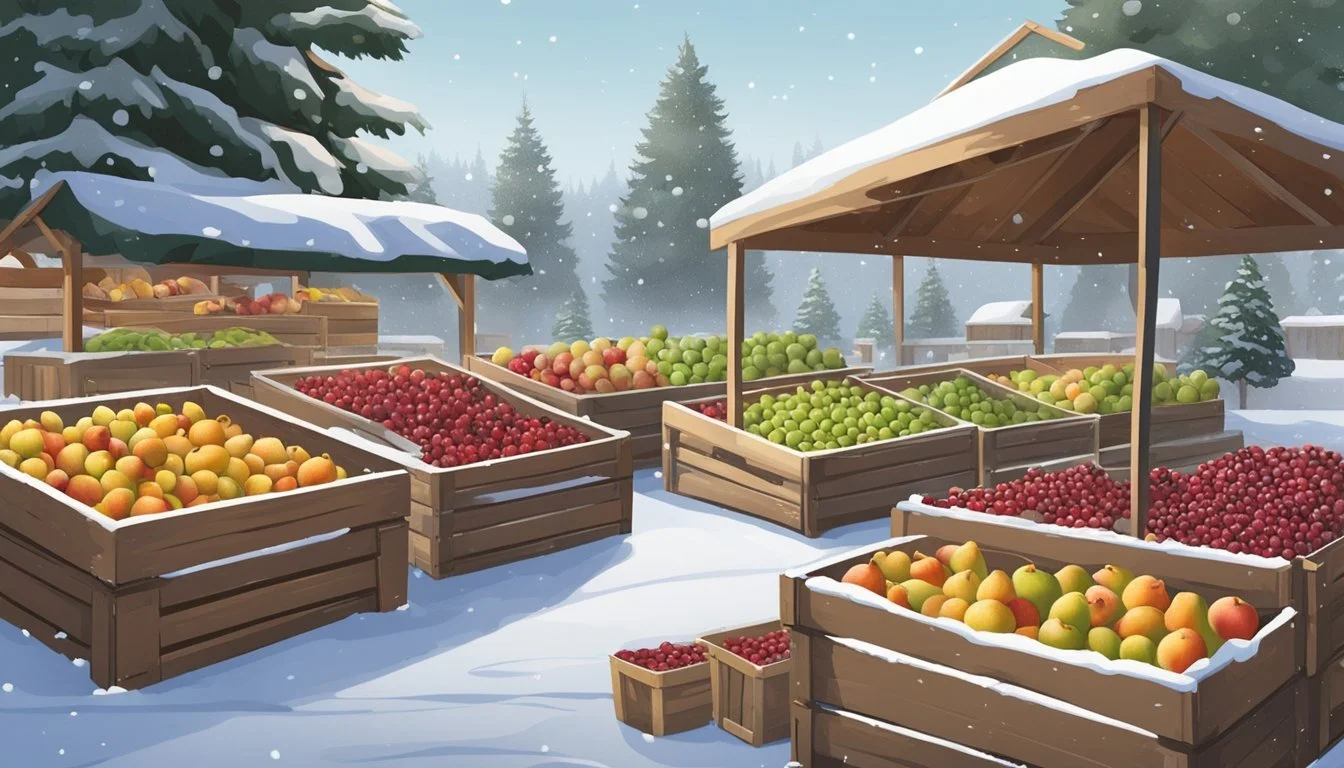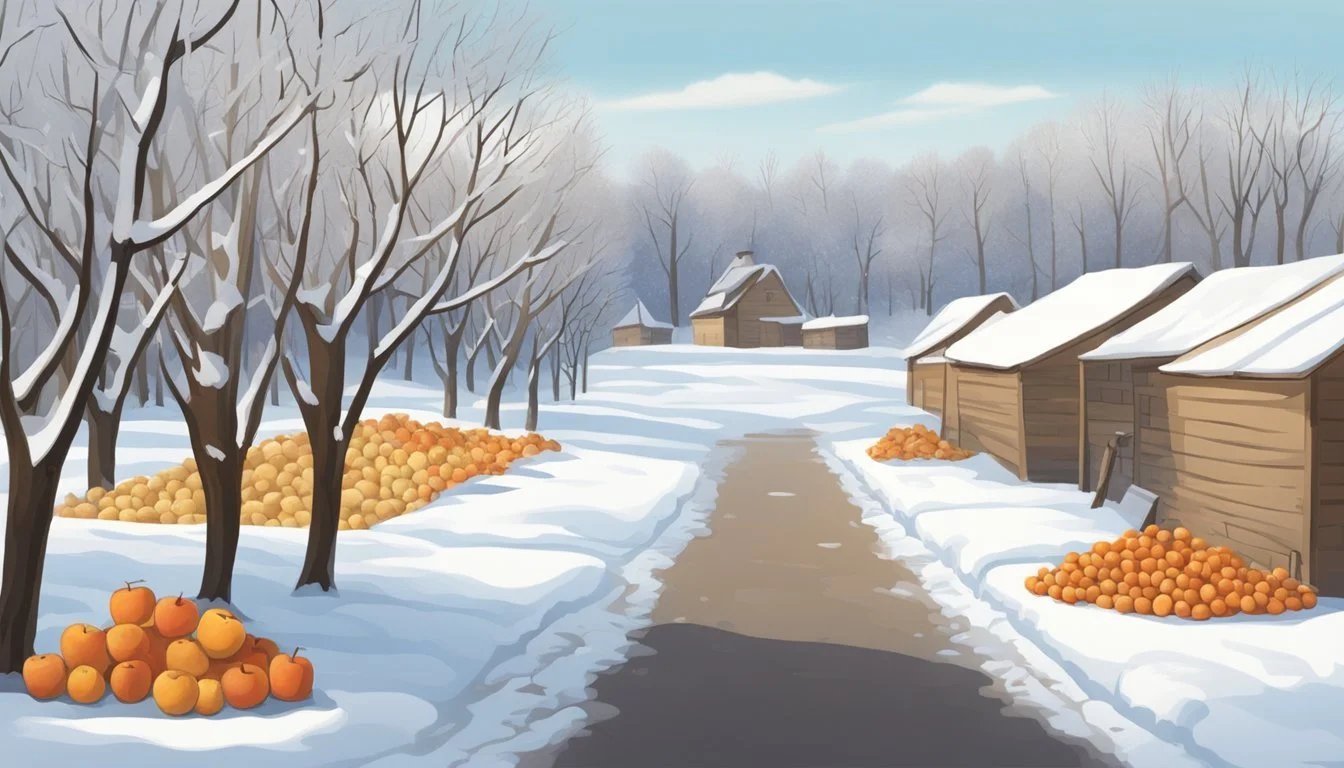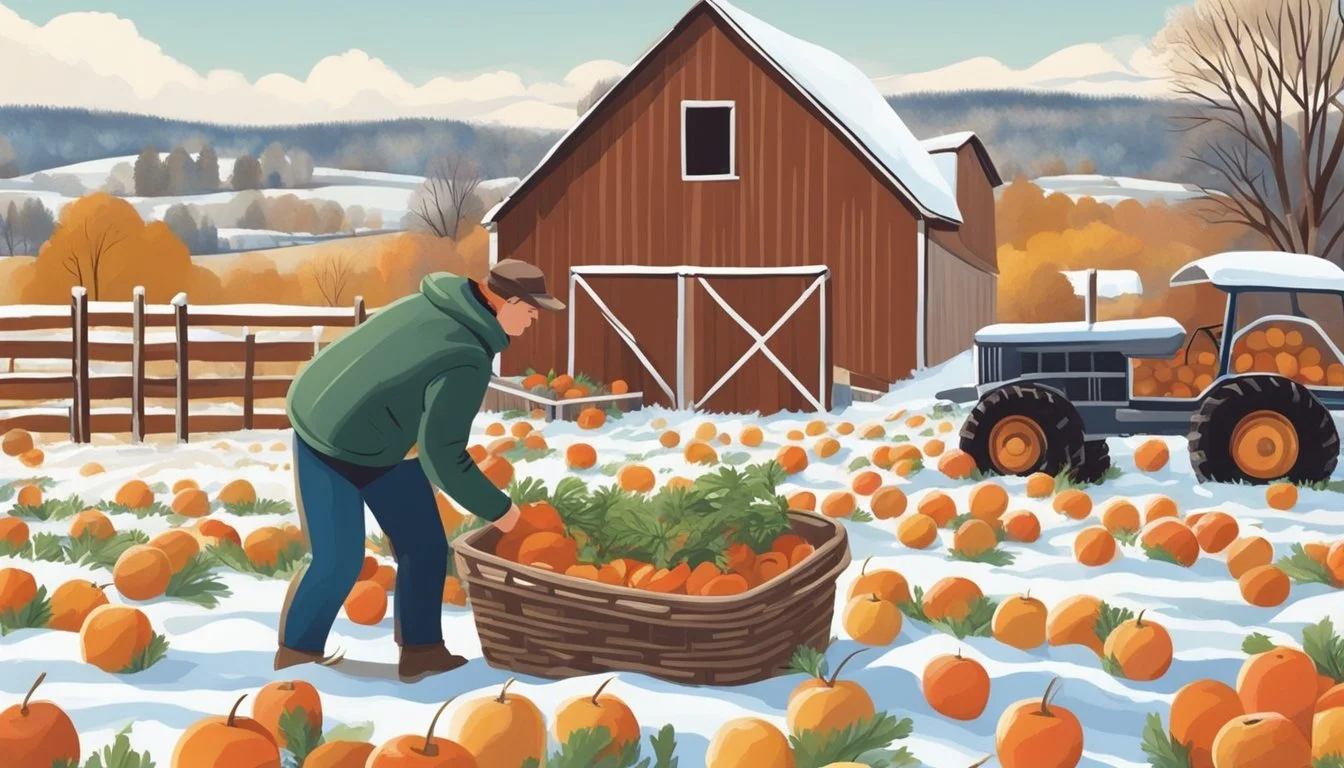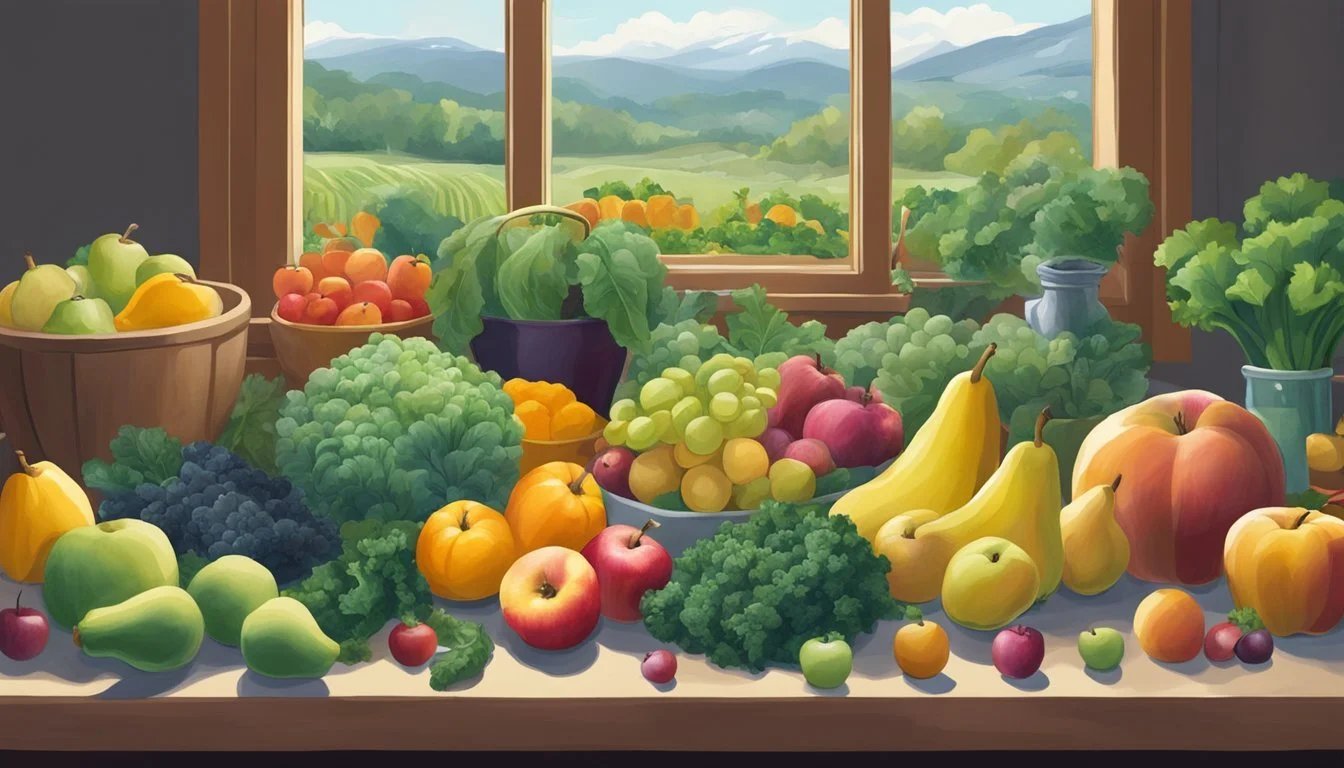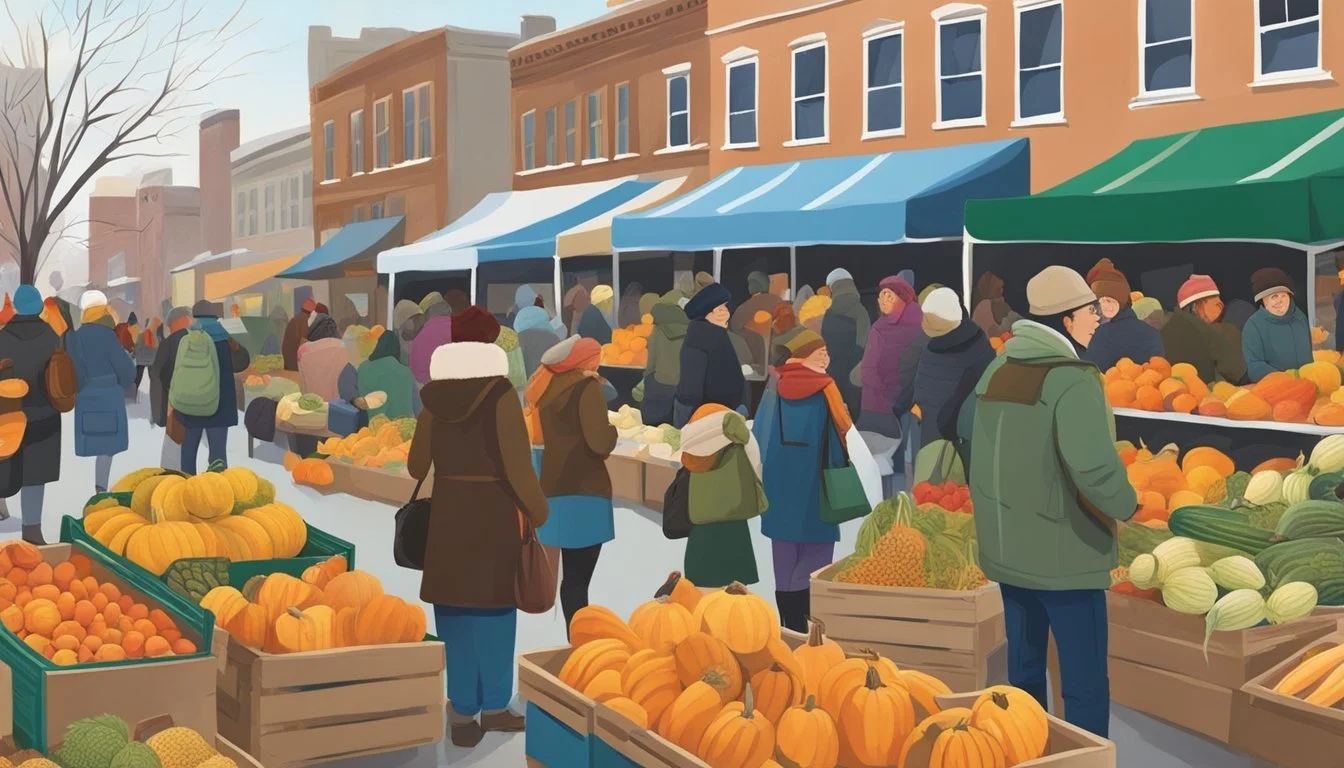Iowa Seasonal Fruit & Vegetables in December
Your Guide to the Best Picks
This Article is Part of our Iowa Seasonal Fruit & Veg Calendar
Amidst the chill of December, Iowa's fields lie mostly quiet, yet this does not spell an absence of produce. Seasonal fruits and vegetables are limited during these frosty months, but the state's hardy selections continue to grace tables with their presence. While summer's bounty is often celebrated for its abundance and variety, winter offers its own suite of produce that can withstand the Iowa cold.
Local markets and grocery stores still feature a selection of fruits and vegetables that are harvested in late fall and available during the winter season. Items such as storage apples and hearty winter squashes, procured before the frost, remain staples during this time. Moreover, root vegetables like carrots (how long do carrots last?), turnips, and parsnips, which are often harvested in late autumn, maintain their quality when stored correctly and can be found fresh in December.
The agricultural landscape of Iowa pivots from the widespread cultivation of corn and soybeans during the warmer months to focus on the crops that are resilient to colder weather. The growth cycle for these winter crops often results in a peak of flavor and nutritional value that is uniquely associated with the season. Thus, the seasonal produce available in December contributes to a distinct regional diet that underscores the Midwestern state's agricultural adaptability.
Iowa's Climate and Seasonal Cycles
Iowa experiences a full range of seasons due to its location in the Midwestern United States. The state's climate is categorized as humid continental, with hot summers and cold winters, each punctuated by distinct transitional seasons—spring and fall.
Winter in Iowa typically spans from December through February. During these months, the temperatures often drop below freezing, and snowfall is common. This cold climate influences the growing season, as many crops are not tolerant to such temperatures.
Average winter temperatures: 20°F to 30°F
Common conditions: snow, frost, and ice
As winter transitions to spring around March, Iowa begins to thaw, leading to a gradual warming trend. This season is marked by increased rainfall, which helps prepare the soil for planting. Spring temperatures and precipitation facilitate the early stages of crop growth.
Average spring temperatures: 40°F to 60°F
Common conditions: rain, thawing, occasional frost
Through summer (June to August), Iowa's agriculture benefits from long, warm days. This season is vital for the maturation of fruits and vegetables due to optimal daylight and heat.
Average summer temperatures: 70°F to 85°F
Common conditions: hot, humid, occasional thunderstorms
Fall sees a decrease in temperatures starting in September. This cooler climate is suitable for harvesting many crops before the first frost, which can occur as early as October.
Average fall temperatures: 50°F to 70°F
Common conditions: cool, diminishing daylight
Each of Iowa's seasons plays a critical role in defining the state's agricultural calendar and influences which crops are grown and when they are harvested.
Overview of Seasonal Fruits and Vegetables
In December, Iowa's produce selection pivots to hardy vegetables and storage fruit that can withstand the chill of winter. Here we highlight what’s typically available during this time.
Winter Squash and Root Vegetables
Iowa’s winters are complemented by a range of substantial vegetables that store well and offer rich flavors and nutrients. Winter squash varieties like butternut, acorn, and spaghetti are commonly available and are versatile for cooking. Root vegetables are at the core of winter produce. December yields a bounty of sweet potatoes (What wine goes well with sweet potatoes?), turnips, parsnips, carrots, and beets (how long do beets last?), perfect for roasting, mashing, and adding to hearty stews.
Leafy Greens and Brassicas
Even as temperatures drop, some greenery persists. Kale and spinach are resilient and can often be harvested during the early winter months, providing a fresh complement to the starchier root crops. Additionally, brassicas such as Brussels sprouts (how long do brussels sprouts last?), cabbage, and collard greens (how long do collard greens last?) are not only available but are said to be sweeter after a frost, making them a desirable component of winter meals.
Late Fall Harvest Fruits
While many fruits are out of season, Iowa’s cold storage capabilities mean that late-harvested apples and pears remain accessible. These fruits are often at their peak of sweetness and are a mainstay in winter cooking and baking. Furthermore, the tail end of cranberry season offers the last fresh berries, which are ideal for compotes, sauces, and holiday dishes.
Selecting and Storing December Produce
December in Iowa calls for special attention to selecting and storing produce to ensure its freshness and nutritional value throughout the season. Proper techniques can keep root vegetables firm, winter squash fresh, and fruits like apples and pears at their sweetest.
Root Vegetables Storage Tips
When selecting root vegetables such as sweet potatoes, turnips, carrots, and beets, look for firmness as a sign of freshness. These nutritious staples, when stored correctly, can last through the cold months. For optimal storage:
Keep in a cool, dark, and well-ventilated place.
Place in perforated plastic bags to maintain humidity.
Avoid washing them before storage as moisture can hasten decay.
Keeping Winter Squash Fresh
Winter squash varieties, cherished for their ability to last, should be picked when they have a hard, tough rind. To ensure they stay fresh:
Store in a dry, well-ventilated area at about 50-55°F (10-13°C).
Keep them off the floor to promote air circulation.
Do not stack as pressure points can lead to spoilage.
Fruit Preservation Techniques
Preserving the freshness of fruits such as apples, pears, and cranberries is essential in December. These fruits, when preserved well, retain their sweetness and nutritive qualities:
Store apples and pears in a crisp drawer of the refrigerator, away from vegetables as they emit ethylene gas.
Wrap fruits individually in paper to prevent bruising and extend their shelf life.
Cranberries are best kept in their original packaging in the refrigerator or frozen for longer storage.
Cooking and Recipes
In the chill of December, Iowa's seasonal produce inspires a variety of cooking methods that bring warmth and comfort to the dining table. Through soups, stews, roasting, and baking, the versatility of winter fruits and vegetables is celebrated in holiday dishes and everyday meals alike.
Hearty Winter Soups and Stews
One can harness the full potential of root vegetables and winter squash through the creation of soups and stews that become culinary centrepieces during the colder months. Hearty recipes like roasted butternut squash (how long does butternut squash last?) soup or a classic beef stew (What wine goes well with beef stew?) with chunky carrots and potatoes offer both nourishment and warmth. They also provide an excellent opportunity to cook in bulk, ensuring there is always a warm dish ready for those frigid evenings.
Ingredients Suggested Recipe Carrots Carrot Ginger Soup Potatoes Hearty Beef Stew Butternut Squash Butternut Squash Soup
Roasting and Baking
Roasted vegetables bring out the sweetness and intense flavors that can only be coaxed from produce through slow cooking. One can take advantage of Iowa's root vegetables by cutting them into uniform pieces, tossing with olive oil, and roasting them to achieve a caramelized exterior. A combination of sweet potatoes, parsnips, and beets makes for a colorful and nutritious side dish. Baking, too, plays a significant role in December, with acorn squash and pumpkins serving as prime candidates for filling, wholesome meals.
Sweet Potatoes: Roasted with a hint of rosemary.
Beets: Roasted and added to a warm salad.
Acorn Squash: Baked with a sweet drizzle of maple syrup.
Holiday Dishes with Seasonal Produce
Holiday recipes often highlight the best of December's produce, incorporating fruits like the tangy cranberry into glazes or salads to compliment any main dish. The season's roots and squash can be transformed into elegant side dishes or form the base of savory pies and tarts that grace the holiday table. With careful preparation, these elements not only contribute flavor but also add a festive touch to the holiday spread.
Cranberries: Used in salads or as a glaze for roasted meats.
Pumpkins: Pureed for pies or incorporated into savory tarts.
Root Vegetables: Presented as part of a seasonal roast.
Health Benefits of Seasonal Eating
Eating seasonally, especially during winter, provides numerous health benefits. Seasonal fruits and vegetables harvested in their peak tend to be more nutritious. This is because they are picked at the optimal time, ensuring a higher concentration of vitamins, minerals, and antioxidants. For example, Brussels sprouts and kale, common in Iowa's December offerings, are rich in vitamin C and can boost immunity during the cold season.
Incorporating these seasonal selections can also support community health. Individuals often find that locally sourced produce, which aligns with the season, is fresher and, consequently, tastier. This can encourage a higher intake of fruits and vegetables, aligning with dietary recommendations for better overall health.
Seasonal Produce Health Benefits Brussels Sprouts High in fiber, vitamins K and C Kale Nutrient-dense, contains powerful antioxidants Broccoli Rich in vitamins A, C, and K, fiber
Consuming seasonal produce like the diverse range of cruciferous vegetables available in December, such as broccoli and romanesco, is known to reduce inflammation—a common ailment in winter. The body may also benefit from their detoxifying properties, promoting a healthy liver.
Lastly, seasonal eating from local sources can be more sustainable, reducing the carbon footprint associated with transportation. This practice supports local farmers and the economy, emphasizing a connection between personal health and the health of the environment.
Shopping for Seasonal Produce
In December, Iowa's markets become a crucial venue for sourcing the freshest local produce. Consumers can utilize farmers markets to find firm and fresh fruits and vegetables while supporting Iowa's agricultural community during the harvest season.
Finding Local Farmers Markets
Farmers markets in Iowa are abundant, and December offers a unique selection of seasonal offerings. Shoppers looking for the freshest produce can visit Local Harvest or Iowa Department of Agriculture and Land Stewardship websites to locate nearby markets. The most accurate tool for discovering these venues is the Iowa Farmers Market Directory, which provides an extensive list of locations operational in the winter season.
Identifying Fresh Produce
To determine the freshness of produce, shoppers should inspect for bright colors and a firm texture. In December, key fresh finds in Iowa include:
Vegetables: Parsnips, sweet potatoes, and winter squashes
Fruits: Apples such as the Envy™ variety
Furthermore, consumers should engage with local growers at the markets, as they can offer valuable insights on selecting the freshest harvest and even provide tips for storage.
Supporting Local Agriculture
Patronizing local markets in Iowa directly benefits the local economy and agricultural sector. December's chilled climate brings a bounty of storage crops and hearty vegetables that thrive in cooler weather. By choosing local produce, one not only enjoys the freshest offerings but also sustains the livelihoods of Iowa farmers who work diligently through the harvest season.

